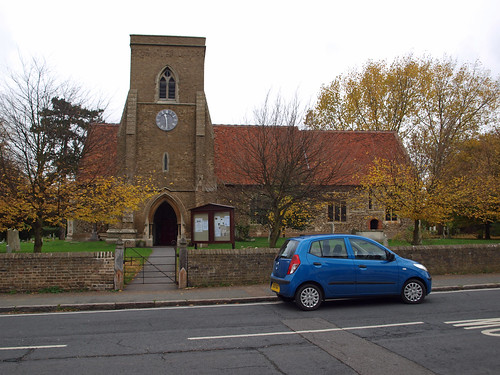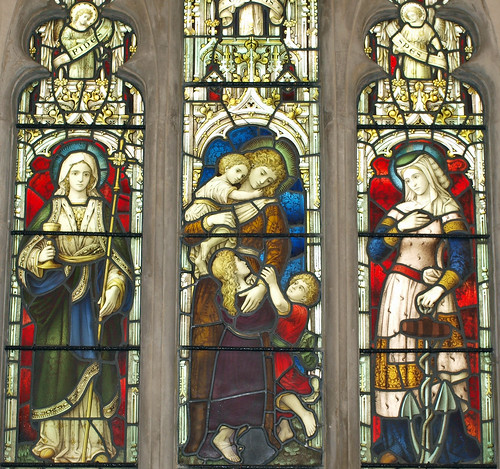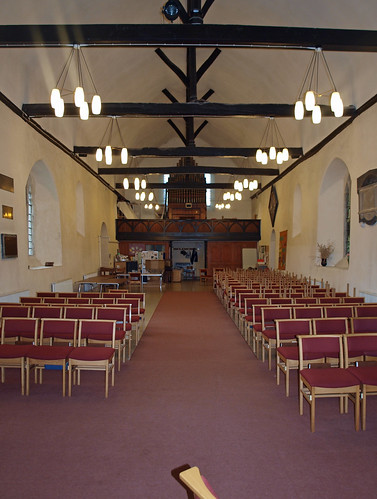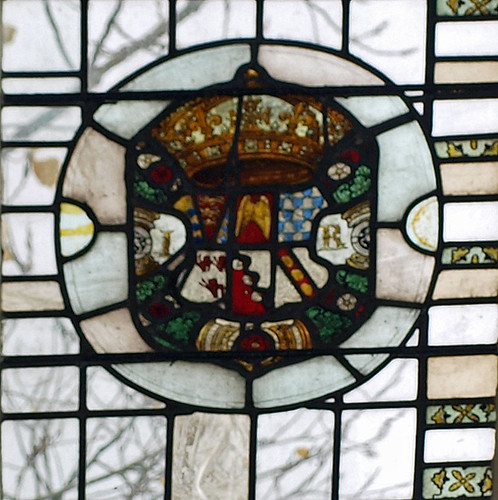I don't want to be rude but St Mary the Virgin is a monstrosity; an 1858 overhaul saw the addition of a truly ugly south tower and it was finished off with a bullet in the back of the head in the early nineties with a happy clappy refurbishment. The interior looks like the offspring of a conference hall and a barn. The view from the north is redeeming, however, revealing clean cut lines and an imposing nave but also the loss of the original west tower. I'm afraid I struggled with this church.
ST MARY. S tower of white brick with porch, 1858. - The nave is Norman and has one of the most ornate doorways in Essex, with one order of columns, a curved lintel with zigzag, a tympanum with three strips of rosettes, also curved, an arch with zigzag and a hood-mould with saltire crosses etc. Norman also. the N doorway and several windows. The chancel belongs to the E.E. period, see some lancet windows. The three tall S lancets are C19 externally, but their internal aspect with detached shafts is original. Good nave-roof with tie-beams, octagonal king-posts with capitals and four-way struts. - FAMILY PEW C18. - PULPIT. Plain, early C17, with some little strapwork decoration. - COMMUNION RAIL. With few heavy balusters, mid C17. - BENCH-ENDS. With two flat poppy-heads like small cartouches. One is dated 1680 and yet has no indication of classical elements. - MONUMENTS. Brass to a Civilian, c. 1510. - Two minor tablets with urns, but without figures by the younger John Bacon, 1801 and 1806.
ST MARY. S tower of white brick with porch, 1858. - The nave is Norman and has one of the most ornate doorways in Essex, with one order of columns, a curved lintel with zigzag, a tympanum with three strips of rosettes, also curved, an arch with zigzag and a hood-mould with saltire crosses etc. Norman also. the N doorway and several windows. The chancel belongs to the E.E. period, see some lancet windows. The three tall S lancets are C19 externally, but their internal aspect with detached shafts is original. Good nave-roof with tie-beams, octagonal king-posts with capitals and four-way struts. - FAMILY PEW C18. - PULPIT. Plain, early C17, with some little strapwork decoration. - COMMUNION RAIL. With few heavy balusters, mid C17. - BENCH-ENDS. With two flat poppy-heads like small cartouches. One is dated 1680 and yet has no indication of classical elements. - MONUMENTS. Brass to a Civilian, c. 1510. - Two minor tablets with urns, but without figures by the younger John Bacon, 1801 and 1806.
HIGH ONGAR. The village has a row of timbered cottages and the church two Norman doorways, one of them a beauty. It is amazing to realise that an axe could create such loveliness from stone. The arch is richly carved and encloses four rows of stones in the tympanum, each one differing in design. Narrow Norman windows still help to light the nave, but the lancet windows of the chancel show that the east end of the church was entirely rebuilt in the 13th century. The three windows in the east wall are of great dignity, two with 16th century heraldic glass in rich colouring; on one of them are the arms of Jane Seymour below the golden crown her royal Bluebeard set on her head, and the other has the arms of Henry the Eighth himself. There is a brass in the floor of the nave with a civilian in the dress he wore when Henry came to the throne. There is a Jacobean pulpit and a memorial pew of 1700 with carving copied from two bench-ends close by it. One of the Earles who were rectors last century preached from this pulpit for 58 years.
Flickr set.




No comments:
Post a Comment